How Can Strength Training Help Runners?
Sports Injury Fix’s resident running expert Mike James recently wrote his top tips on injury free running and follows this up by expanding his thoughts on the hot topic of strength training for runners.
Original Article:
https://www.sportsinjuryfix.com/blog/how-can-strength-training-help-runners?fbclid=IwAR3gjKCWw8zcmKq8O4RT_c6P09SVJgB6W6qGqc5sYyERL4mXjz8-ArobTEI

Benefits of Strength Training
The injury incidence among runners varies between 11–85%, or 2.5 to 38 injuries per 1000 hours of running.1,2 Research suggests that the top 3 benefits of strength training are:
1. Reduce overuse injuries
2. Improve running economy
3. Improve performance
Strength training has been shown to reduce overuse injuries by up to 50% and improve performance.3,4 A recent review found that strength training improved running economy by 2-8% and time trial performance by 2-5%. It also dispelled many common misconceptions relating to strength training being detrimental to endurance activity as maximum oxygen uptake, blood lactate and body composition all appeared unaffected.5
Get strong and stay strong, coupled with appropriate management of training load and recovery appear to be the biggest factors we can actively affect in reducing injury risk and improving performance.
Despite such obvious benefits a large proportion of runners do not undertake regular strength training. In fact, a study of 2008 US Olympic marathon triallists found that roughly half did not do any whatsoever.6 This statistic is anecdotally supported whenever I question runners in clinic, at race events or during the courses and workshops that I present.
Misconceptions of Strength Training
I believe many age old, long held misconceptions exist regarding within the established running community. The top six misconceptions on strength training are:
1. Fear that it will negatively impact endurance performance
2. Increases in body mass
3. Be detrimental to their training
4. Are not ‘functional’ for running
5. Are less important for injury reduction than stretching
6. That it is complicated to master and needs instruction from an expert
When these are combined with time constraints, work and family commitments, the belief that it needs to be undertaken in a gym, and a failure to appreciate the potential positive benefits then it is understandable why it hasn’t become a staple part of the runners training regime.
Making the Most of Strength Training
When I do come across runners who perform some degree of strength training, then they often do so with the outdated belief that as an endurance athlete they should perform high reps/low resistance workouts to target endurance capacity. Whilst this may be more beneficial than performing zero strength training, it may fail to maximise the benefit available. Eventually, when skill acquisition and confidence of the low load exercises is achieved, low repetition, high load appears more beneficial to the runner than remaining at high repetition and low load. Building a greater capacity to tolerate forces and generate power will ultimately provide a greater stimulus for the system to perform and reduce injury risk.
The current evidence appears to support the notion of performing concurrent strength and endurance training for maximum benefit that includes increased movement economy 7, reduced / delayed fatigue 8, increased maximal speed and enhanced capacity anaerobically. 9 As with all training regimes though, compliance is key.
In summary I believe strength training has the potential to produce a more robust, economical runner with a reduced likelihood of injury when coupled with appropriate training and recovery schedules.

How to Start Strength Training?
So, we’ve established that strength training is worthwhile but how and where do you start? Do you have to join a gym? The key is to keep it simple and then progress as you feel comfortable and see benefit. We know that a large proportion of people fail to adhere to exercise, even when part of a rehabilitation plan, and a major factor in this is unclear instructions 10. For that reason I believe that the top two tips when starting are:
1. Do it at home
2. Use Bodyweight exercises
The guide below gives a simple regime of 6 exercises that can be completed 2-3 times a week and less than 20 minutes a session.
A beginner’s guide to strength training for runners at home:
As with all training regimes, compliance is key, and I have designed a simple regime of home, bodyweight-based exercises for the runner to try. Blagrove et al 5 states that the most effective type of training prescription is difficult to identify at present but suggests an optimal dosage may be 2-3 x week for 6-14 weeks (longer is better!) and when run training increases in the lead up to a race, then once weekly may be sufficient to maintain gains.
On a practical level, try to allow 3 hrs after high intensity running before performing strength training, and allow at least 24 hrs recovery afterwards before completing high intensity running.
Aim to complete 4 sets of 8-12 repetitions of each exercise. This can be performed as a circuit or one exercise at a time. Allow around 30-60 seconds rest between sets as required.
Should the exercises become easy, or you are already performing bodyweight exercises, then adding some resistance as shown below is advised. Simple equipment such as water bottles, sand bags, rucksacks filled with books will add extra resistance, however, if you have access to simple fitness equipment such as dumbbells, kettlebells and resistance band, then they work well also. Again, aiming for 8-12 repetitions per set, 3-4 times.
This is by no means an exhaustive list of exercises for the runner. They are simply an introduction to strength training at home. Exercise dosages are simply a starting point for the general runner and should the runner wish for further progression and/or to develop specific components of strength, such as power or plyometric ability, then guidance should be sought from an expert.
Exercise 1 – Squat
Squatting is a common daily task that is common place in many strength training regimes. When we look for “most bang for your buck” type exercises, then it’s no surprise the squat is at the top of the list. By nature of its multi joint strength and control demands encompassing many types of muscle contraction, then it becomes a fundamental exercise for the runner.
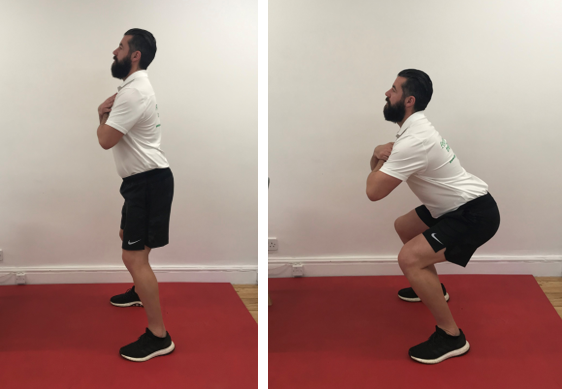
Air squat – feet shoulder width apart, stay tall and strong, lower with control to a depth you can control and then drive through the legs to return to the start position.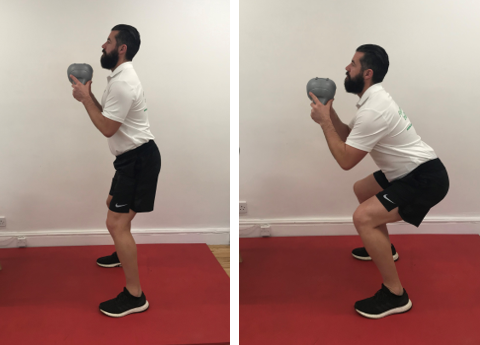
Progression – add resistance – this variation is called the goblet squat and adds both resistance to the lower limb and trunk control. Wearing a ruck sack converts the exercise to a traditional back squat type movement. Try to avoid excessive forward lean, knees tracking over the toes and the knees collapsing inwards at the bottom of the squat. Try to keep the chest up as if to show off your favourite race T-shirt to someone in front of you. Progression through to heavier resistance and / or a single leg squat variation would be appropriate.
Exercise 2 – Deadlift
Another fantastic multi joint movement with excellent emphasis on the posterior chain. Whereas the squat is a knee driven exercise, the deadlift is a hip driven movement, meaning, most movement is a pivot / hinge at the hip whilst keeping an upright strong trunk. The knees will need to bend when you feel the hamstrings pull. Only lower as far as you feel you can control, then drive back to start.
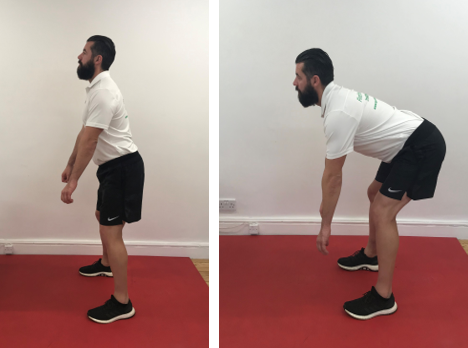
The deadlift can be a difficult exercise to master and may require practise of a simple hip hitch movement before developing into the full technique. A simple technique is to stand a few inches from the wall, try to touch your buttocks against the wall without bending the trunk or knees.
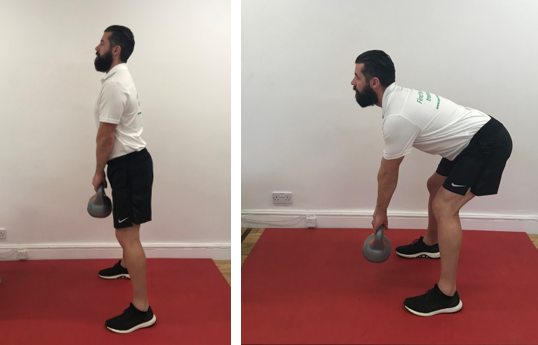
If performing well, add resistance as above, or try a single leg version (below). Running involves significant amounts of single leg support and control and this is an excellent exercise for targeting this. It is an advanced technique and takes time to master.
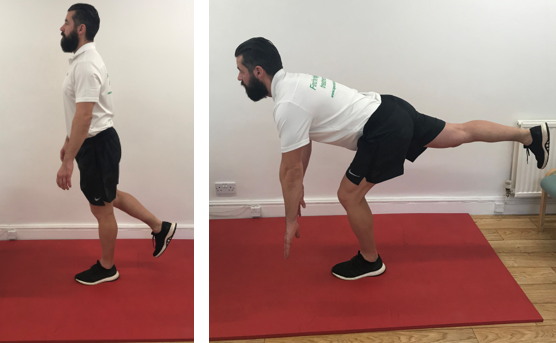
For each deadlift variation, aim to keep your hips higher than your knees, your buttocks moving back rather than down, and your trunk and upper limbs square and facing forward. Add resistance again as tolerated.
Exercise 3 – Calf Raise
An essential exercise for runners. The calf complex and Achilles tendon transmit and absorb massive forces and increased capacity in these tissues will almost definitely benefit the runner. Begin with a finger tip supported drill if required, potential strength gains and loading should not be affected by limitations in balance and coordination. Always concentrate on full range movement right up onto tip toes and with control. Time under tension is crucial for these muscles.
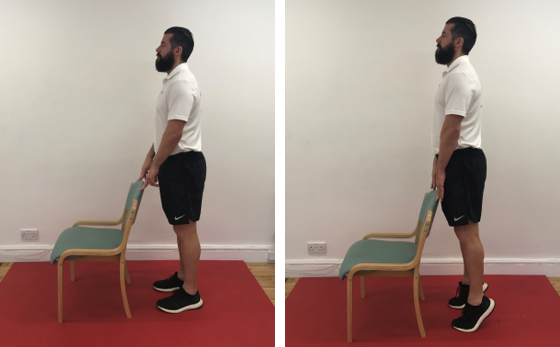

Perform with both straight leg (Gastrocnemius biased) and bent leg (Soleus biased) variations to maximise effect. The key cue is to always move in a vertical direction with the ball of your foot in contact with the floor.
Performing on single leg is an effective progression (straight leg shown only but remember to perform with bent leg also.
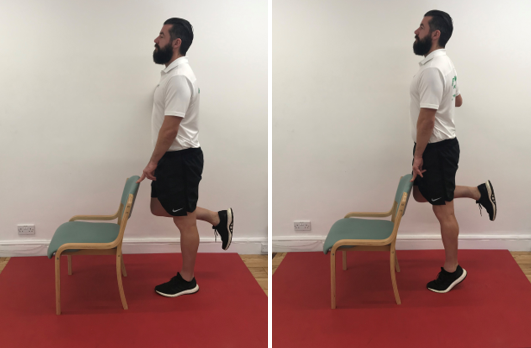
Finally, performing both types over a step / stair will allow you to take the heel “below the level of the floor” and increase the range the muscles can work through. An effective strategy for increasing resistance safely is to use a rucksack with weight in it. This will allow you to maintain your hands in a free position should fingertip support be required. These progressions are merely options and do not all necessarily need to be performed to progress. Simply adding load and / or more time under tension (taking longer to perform the repetition) may be appropriate.
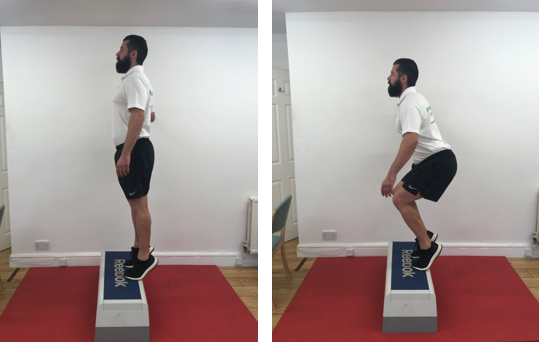
Exercise 4 – Bridge
Another fantastic posterior chain activity, easily performed at home without the need for expensive, complicated equipment. Begin with the double leg variation. Raise your buttocks/trunk off the floor, aiming to achieve an imaginary straight line running through your knees, hips and shoulders, variations include a very slow and controlled raise/lower or a faster raise and lower with a small pause at the top position.
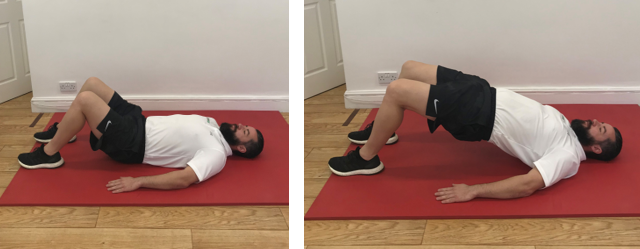
Key errors to avoid are overarching of the lower back, failure to raise to the top position and holding the breath throughout the movement. Play around with foot positions to bias certain muscle groups more or less than others. Bringing the heels closer will increase Gluteal work, whilst moving them further away will increase hamstring activity – be careful they don’t cramp!
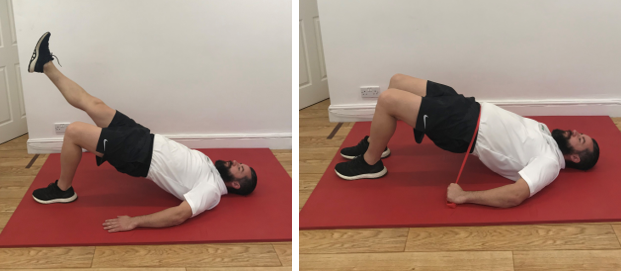
To progress either move onto a single leg variation or add resistance across the pelvis as illustrated below.
The resistance band can also be performed on the single leg variation as required.
Exercise 5 – Step Up
Another great fundamental exercise that demands stability and control throughout the single leg as per the actions required for every stride when running. Be cautious when selecting the height of the step to be used. Don’t get too ambitious too soon if new to this exercise. Key coaching cues include driving up through the weight bearing foot/leg and maintain control throughout. Many runners perform this exercise based on the momentum generated from the movement and this should be avoided. Remember the resistance level used shouldn’t compromise the control on the down phase whilst returning to the floor.

Adding an upper limb movement that replicates a running pattern whilst progressing to a high knee step up variation is an effective technique for runners to develop. Once mastered, adding resistance to the step up (again, a loaded rucksack is often sufficient) can be effective. Other techniques to increase resistance include the following. Give them a go and see which ones you find the most beneficial.
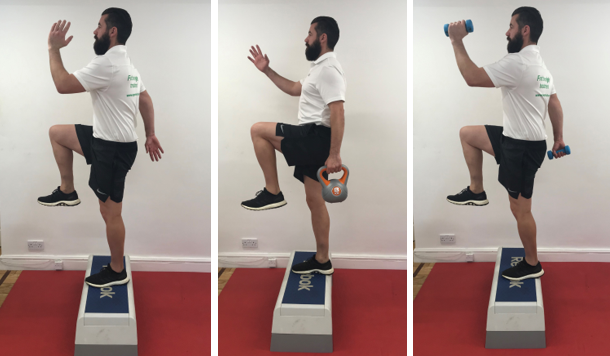
Exercise 6 – Core
The topic of core strengthening is much debated and controversial. Many exercises such as the plank have been advocated as effective exercises for runners. Personally, I feel core work needs to include two aspects: controlled rotation and an anti-rotation element to encompass the demands of running. Here are two variations that focus on these aspects.
6a. Anti-Rotation via Pallof press
I find resistance band is perfect for this drill. A resistance band can be found in many high street shops and/or online. It is manufactured in different grades of resistance differentiated by colour.
For this exercise – position yourself so that there is enough tension on the band to make you feel like your trunk wants to rotate towards the band. Whilst resisting the rotation, drive /push your arms forward, this will increase lever length and increase the effort needed to resist rotation towards the band. Perform with the band pulling from both sides of your body. It can be performed in kneeling or standing depending on level of ability. I particularly like the single leg standing variation as a high-level drill, but as with all the exercises, this requires time and patience to master and progress to.
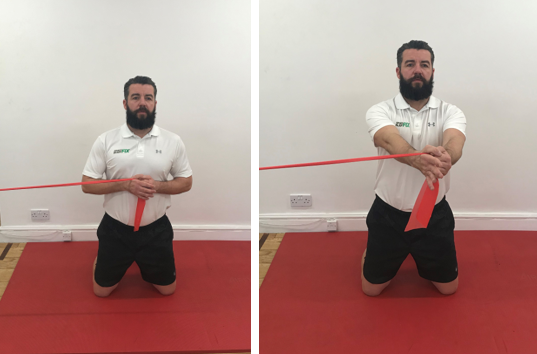
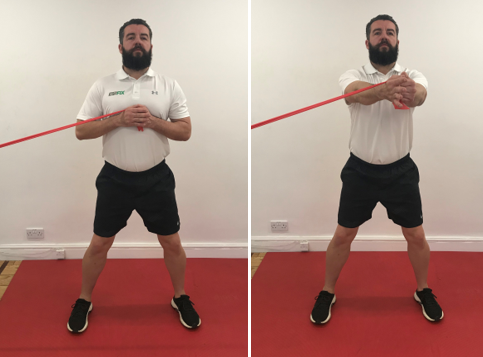
6b. Rotations
For this exercise the intention is to do the exact opposite of the Pallof press. We are aiming to rotate against the band whilst maintaining control throughout. Focus on trying to rotate through the trunk and not by simply turning the hips and pelvis. Again, perform in kneeling, standing or eventually on single leg, progressing only when control is effectively maintained. It is important to maintain control on the return to the start; a common mistake is to use a resistance that is too heavy, and the return phase becomes a recoil as opposed to a controlled movement.
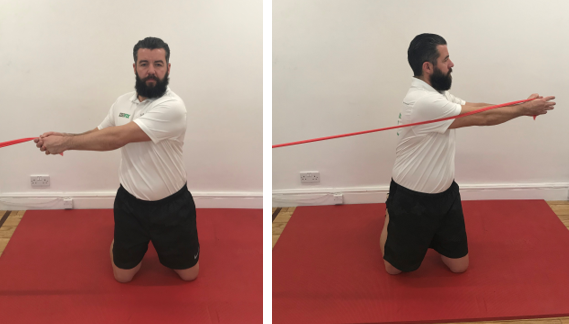

Hopefully you may find these helpful and effective at improving your running and reducing injury risk. We’re really excited to hear how you get on so please let us know via social media Twitter and/or Facebook
If you have any queries, please seek the assistance and advice of a running specialist via sportsinjuryfix.com

References
1.Buist I, Bredeweg SW, Bessem B, et al. (2010) Incidence and risk factors of running-related Injuries during preparation for a 4-mile recreational running event. Br J Sports Med. 44(8), 598-604.
2.van Gent R, Siem D, Van Middelkoop M, et al. (2007) Incidence and determinants of lower extremity running injuries in long distance runners: A systematic review. Br J Sports Med. 41(8):469–480.
3.Bredeweg S, Zijlstra S, Bessem B, et al. (2012). The effectiveness of a preconditioning programme on preventing running-related injuries in novice runners: a randomised controlled trial. Br J Sports Med.46:865-870.
4.Lauersen J, et al. (2014). The effectiveness of exercise interventions to prevent sports injuries: a systematic review and meta-analysis of randomised controlled trials. Br J Sports Med. 48:871–877.
5.Blagrove R, Howatson G, Hayes P. (2018) Effects of strength training on the physiological determinants of middle- and long- distance running performance: A systematic review. Sports Med 48:1117-1149.
6.Karp J. (2007) Training characteristics of qualifiers for the U.S. Olympic Marathon Trials. Int J Sports Physiol Perform. 2:72-92.
7.Storen O, Helgerud J, Stoa E. et al (2008) Maximal strength training improves running economy in distance runners. Med Sci Sports Exerc 40:1087-1092.
8.Aagaard P. (2003) Training-induced changes in neural function. Exerc Sport Sci Rev 31(2):61-67.
9.Mikkola J, Rusko H, Nummela A. et al. (2007) Concurrent endurance ad explosive type training improves neuromuscular and anaerobic characteristics in young distance runners. Int J Sports Med 28(7):602-11.
10. Sluijs, E, Kok, G, & van der Zee, J. (1993) Correlates of exercise compliance in physical therapy. Physical Therapy, 73(11), 771-782.


